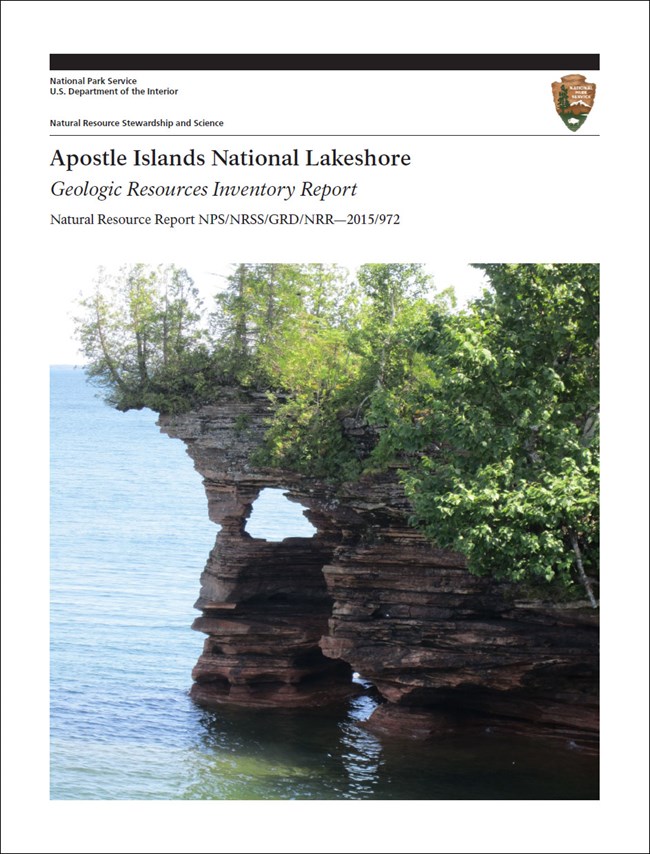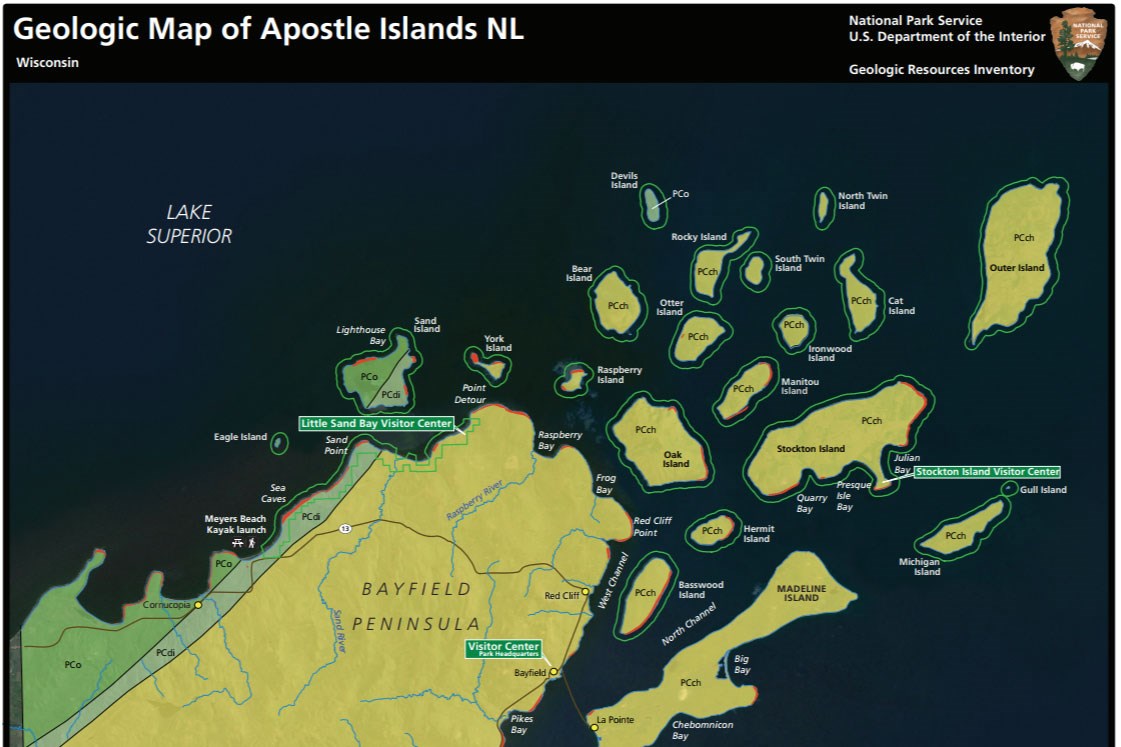Last updated: June 17, 2024
Article
NPS Geodiversity Atlas—Apostle Islands National Lakeshore, Wisconsin
Geodiversity refers to the full variety of natural geologic (rocks, minerals, sediments, fossils, landforms, and physical processes) and soil resources and processes that occur in the park. A product of the Geologic Resources Inventory, the NPS Geodiversity Atlas delivers information in support of education, Geoconservation, and integrated management of living (biotic) and non-living (abiotic) components of the ecosystem.

Introduction
Apostle Islands National Lakeshore (APIS) is an archipelago park unit that includes 21 of the 22 islands in southwestern Lake Superior in Ashland and Bayfield Counties, Wisconsin. The lakeshore also includes 19 km (12 mi) of mainland shoreline along the northwestern edge of the Bayfield Peninsula. Established on September 26, 1970, APIS encompasses about 28,075 hectares (69,377 acres) that includes sea cliffs, sea caves, seascapes, terraces, wave-cut benches, arches, beaches, and old growth forest. Inland features of APIS include glaciated landscapes where glaciers eroded bedrock, forming grooves and striations, and deposited thick mantles of glacial sediments (Thornberry-Ehrlich 2015). The namesake for the park unit is uncertain, but may stem from early French explorers, who referred to them collectively after the 12 biblical apostles, or perhaps the name was inspired by a band of thieves who used the straits, caves, and coves of the islands when hijacking the payloads of fur traders (Stucker 1974; Thornberry-Ehrlich 2015).
Geologic Setting
The geology of APIS includes units that date back more than one billion years and form the basement rock for all the islands. Exposed strata within APIS consists of the Mesoproterozoic Bayfield Group, including the Orienta Sandstone, Devils Island Sandstone, and Chequamegon Sandstone. These sandstone units were deposited in sand flats and a series of braided streams and shallow lakes within the failed Midcontinent Rift System of the North American craton (an ancient, stable part of continental crust). Volcanic rocks associated with the rift system are buried beneath the sandstones of the Bayfield Group. More than a billion years after the sandstones of the Bayfield Group were deposited, Pleistocene glaciation intermittently advanced and retreated across the Lake Superior region, eroding the bedrock between resistant rock knobs that would become the Apostle Islands (Thornberry-Ehrlich 2015). A series of glacial deposits are found throughout APIS and include the Miller Creek and Copper Falls Formations. Locally, the Bayfield Group is overlain by postglacial shoreline sediments, representing an unconformity (period of nondeposition or erosion) of nearly 1.1 billion years.
Paleontological Resources
All NPS fossil resources are protected under the Paleontological Resources Preservation Act of 2009 (Public Law 111-11, Title VI, Subtitle D; 16 U.S.C. §§ 470aaa - 470aaa-11).
Cave and Karst
All NPS cave resources are protected under the the Federal Cave Resources Protection Act of 1988 (FCRPA)(16 U.S.C. § 4301 et seq.).
Abandoned Mineral Lands
NPS AML sites can be important cultural resources and habitat, but many pose risks to park visitors and wildlife, and degrade water quality, park landscapes, and physical and biological resources. Be safe near AML sites—Stay Out and Stay Alive!
Regional Geology
Apostle Islands is a part of the Superior Upland Physiographic Province and shares its geologic history and some characteristic geologic formations with a region that extends well beyond park boundaries.
- Scoping summaries are records of scoping meetings where NPS staff and local geologists determined the park’s geologic mapping plan and what content should be included in the report.
- Digital geologic maps include files for viewing in GIS software, a guide to using the data, and a document with ancillary map information. Newer products also include data viewable in Google Earth and online map services.
- Reports use the maps to discuss the park’s setting and significance, notable geologic features and processes, geologic resource management issues, and geologic history.
- Posters are a static view of the GIS data in PDF format. Newer posters include aerial imagery or shaded relief and other park information. They are also included with the reports.
- Projects list basic information about the program and all products available for a park.
Source: NPS DataStore Saved Search 2706. To search for additional information, visit the NPS DataStore.
A NPS Soil Resources Inventory project has been completed for Apostle Islands National Lakeshore and can be found on the NPS Data Store.
Source: NPS DataStore Saved Search 2696. To search for additional information, visit the NPS DataStore.

(NPS photo by Neil Howk)
Related Links
Related Articles
Apostle Islands National Lakeshore
National Park Service Geodiversity Atlas
The servicewide Geodiversity Atlas provides information on geoheritage and geodiversity resources and values within the National Park System. This information supports science-based geoconservation and interpretation in the NPS, as well as STEM education in schools, museums, and field camps. The NPS Geologic Resources Division and many parks work with National and International geoconservation communities to ensure that NPS abiotic resources are managed using the highest standards and best practices available.

